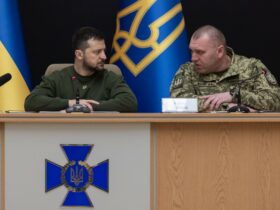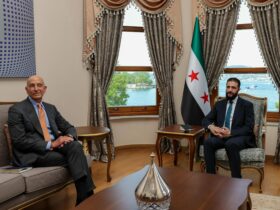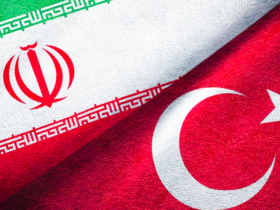Ataturk gave the following speech after İsmet İnönü had visited Athens and met Greek Prime Minister Metaxas in 1937 under the auspices’ of the Balkan Pact: “The borders of the Balkan allies are indivisible within the Balkans. Those who lay their eyes on these unified borders will be scorched by the sun’s blazing rays. I would recommend this to be totally avoided. The friendship in the Balkans would mean something, as long as this point is carefully considered. This is the actual humanitarian and the civil goal of the Balkan Pact.” This was a clear message to the Fascist Italy and to Mussolini, who had already laid their eyes upon Greece.
TURKISH-GREEK RAPPROCHEMENT
The Turkish-Greek rapprochement, which began 7 years earlier under the leadership of Ataturk on October 29th 1930, when Prime Minister Venizelos (the main person held responsible for the Asia Minor Catastrophe) came to visit Ataturk in Ankara. The Ankara Friendship Treaty between Greece and Turkey was signed one day later on October 30, 1930. Our neighbor Greece supported Turkey’s entry into the League of Nations in 1932 and became a member of the Balkan Pact, which was realized under the leadership of Turkey in 1934. Greece also supported Turkey to restore its absolute sovereignty in the Turkish Straits during the process of Montreux Convention in 1936. However, the Balkan Pact and the Turkish-Greek Friendship Treaty failed to prevent Italian expansionism and the imperialist appetite of Nazi Germany supporting it.
ITALY ATTACKS GREECE
On August 15, 1940 the Greek freighter ship Elli was sunk by Italy. On October 28, 1940 Italian armies entered through the Albanian border and began the invasion of Greece. Turkey quickly backed its neighbor by deploying its troops on the Bulgarian border, deterring Bulgaria from simultaneously invading Greece. Greece was being invaded for the first time in the 110 years of its young life. As a twist of fate, almost 25 years after the invasion of Izmir in May 1915, the nation was facing the same fate themselves. At that time they had the Great Britain supporting them, while Nazi Germany was supporting the Italians this time. But they were not easy prey for the Italians, managing to stop the Italian advances in a six-month defensive, especially in the mountainous northwest region. Greece was so important in taking control of the Balkans and the Eastern Mediterranean that Hitler had to step in after the Italian failure and they launched the invasion on April 6, 1941. Before this campaign, they had persuaded Bulgaria to join into a tripartite pact on March 1, 1941, which would have led them to ally with Italy and Germany. There were no obstacles left between the German troops in Romania and Greece. Unable to withstand the German armored divisions, Greece had to surrender only a week later on April 26. After the Germans took control of the entire mainland with the Italians, they began the occupation of the strategic Island of Crete on May 20, 1941. They struggled intensely during the invasion, and only on June 2, 1941 was the Island of Crete, which is strategically important for the Eastern Mediterranean, captured. As a result of the invasion, the Greek Prime Minister Tsouderos committed suicide. In July 1941, all of Greece and the remaining Aegean Islands were under German occupation.
THE GREAT FAMINE
Greece was planned to provide food support to the ongoing military operations in the Balkans and on the Russian front. Right after the invasion, German troops plundered 1,770 Greek villages that made their livings with agriculture. Almost half of the livestock such as horses, donkeys and cattle in the country have been slaughtered, which led to the agriculture and livestock herding go bankrupt across the entire nation. Greece, with a population of 7.5 million, was faced with a famine. Not even grains were left to eat in the cities, people had to walk for hours up onto the mountain tops and forage for wild weeds. In 1940, two and a half pounds of bread was 30 Drachmas in Athens, while in 1944 it was around 34 million Drachmas. In mid-1941, 3,000 people were starving to death in the country every single day. The streets were filled with dead bodies who lost their lives scavenging for food. The losses increased as the time went on. By the end of 1942, 1.5 million people had already starved to death.
THE ORPHANED CHILDREN
Children were most affected by the famine. At the end of 1941, the number of orphaned children on the streets was around 265,000. It was told that nine out of every ten children born in the major cities such as Athens, did not manage to survive more than six months. By 1945, 200,000 children were left on the streets. There were only 30 orphanages with a total capacity of 2900 beds in the entire country. The Greek Prime Minister Tsouderos once said: “With the intention of scientifically destroying the Greek nation, the invaders systematically starve the people to death. Therefore, it is now a necessity to send the children from the impoverished families, to the Middle East and other nearby countries to at least save the next generation.”
GREEK REFUGEES
Wealthy families had the opportunity to escape before the German occupation. They sought refuge in Turkey as the closest neutral and friendly country. A significant number of Greeks were first migrating to the Aegean Islands, and then to mainland Turkey as refugees. Some of them were being sent to Cyprus as well. Similarly, the citizens within the Bulgarian-occupied areas after the German occupation headed to the Turkish border. A total of 5000 Greeks were killed on the Greek-Bulgarian border in 1942 alone, and the great migration began. Among those who were most affected by the Nazi occupation were the Sephardic Jews living in Greece. The Germans began their hunt for Jews there as well. In early 1943, an entire Sephardic Jewish community, roughly equal to a fifth of Thessaloniki’s population, were sent to the Auschwitz Concentration Camp, only in a few weeks. A total of 67,000 Jews, or roughly 87% of the Jewish population, have died at the end of the war. Turkey also played a role in the rescue of 30 Jewish people, from the Island of Rhodes.
THE SITUATION IN TURKEY WAS ALSO BLEAK
How were things in Turkey during these same years? Due to the nationwide mobilization, industrial and agricultural production had fallen. There was a speculation about a major economic crisis in the near future. On January 18, 1940 the National Protection Act was put in place. On March 1, 1941 Turkey shared a border with Nazi Germany when Bulgaria joined the Axis. As of April 24, 1941, Turkey was subjected to a German invasion through Greece and the Aegean Sea, in addition to being exposed from the Bulgarian border. In Thrace, 1.5 million soldiers were ready for Hitler’s attack. However, our army lacked the proper mobilization and maneuverability capabilities. The storage capacity of all the fuel storage tanks in Turkey could only hold 10,000 tons, and did not have armored vehicles to defend Thrace against the German panzer divisions. The army’s weapons and equipment were not sufficient and were outdated for modern warfare. The military logistics were still provided with horse-drawn carriages and camels in Thrace. During a shortage of animal feed, animals sometimes tried to eat each other’s tails. The army rations for the troops were awful. It was the same for civilians as well. On January 14, 1942 bread was rationed; starting October 14, 1942 sugar was as well. The state budget was so insufficient that the Minister of Trade Minister Mumtaz Okmen, who struggled to properly feed the civilians and the army, made a suicide attempt. As a result, the Wealth Tax was pushed through on November 11, 1945, something which is questioned even to this day. While the Wealth Tax was expected to collect around 465 million liras, only 300 million liras were collected.
TURKISH HOSPITALITY
Despite its own difficult and dire situation, the Turkish nation could not remain silent to the horror in neighboring Greece. While many countries ignored the Greek Government’s request for help out of fear of Germany, Turkey decided to send aid to its neighbor. The aid decision was accepted by both the Greek exiled government in Great Britain, and by the Colakoglu Government, which was formed after the occupation of Greece, and thus a legal basis was established. Turkey took responsibility for sending 50,000 tons of food to Greece. Turkey, which was rationing the bread for its own people, initiated a campaign to help Greece. After all the massacres and atrocities at the hands of the Greeks in the Aegean Region between 1919 and 1922, the Turkish people were still ready to send the very food they needed to survive, 20 years later. In October , 1941, Vatan Newspaper announced the aid with the following headline: “For the starving brother nation.” On March 29, 1942 Vakit Newspaper ran the headline “Two neighboring countries, two brotherly homes.” The Red Crescent was the driving force of this aid.
THE SS KURTULUS FREIGHTER
Turkey extended a helping hand to its neighbor, despite being on the verge of a serious famine. It was decided that the aid should be sent by the sea. The first ship to deliver this aid was called SS Kurtulus (Liberation). The 58-year-old 2800-ton, 75-meter-long Kurtulus freighter delivered its first aid cargo in Piraeus Port on October 13, 1941 under the command of Captain Rıdvan Ur. Captain Ur and the ship’s crew were so worried from the situation they saw, that they even left some of their own shipboard rations. When the ship returned back to Istanbul, Vatan Newspaper quoted what was seen in the Piraeus with the headline of “The Story of the Man From Hell.” The news led to the further increase of aid being sent. Local governments, industrial lodges and professional organizations all donated, and support snowballed. Thus, thanks to this old ship, which carried out five cargo-loads of aid in 1941 and 1942, it was possible to save up to 500,000 people on the brink of death. On the sixth journey, the ship drifted and sank in the Marmara Island near the town of Saraylar due to a storm it was caught in after its departure from Istanbul on February 21, 1942. Luckily there were no casualties. The loss of the ship was a great devastation for the Greek people. Each time the freighter arrived in the Port of Piraeus, it was a symbol in the fight against famine. In the minds of thousands of starving people, “Kurtulus” ceased to be an ordinary ship, and rather became a myth in Greece. The Greeks, who had been waiting for Kurtulus with hope in the Piraeus Port, would call the Turkish sailors with the nickname the ‘Second Hristo’, while they have hung a picture of the ship on one of the busiest streets in Piraeus and named one of the streets of Athens after the ship. Kurtulus was a symbol of hope for the Greek people, with its aid transportations during Greece’s most difficult times. They told their children that “yes, you might be hungry today, but tomorrow Kurtulus will come,” for many years. Kurtulus’ mission was transferred to SS Dumlupinar (it is as if destiny had knowingly chosen the names of these ships.) A total of 14 commercial vessels and the navy’s TCG Simsek and TCG Hızırreis patrol vessels participated in delivering food aid, which continued until 1949. However, the Greek people continued to use the name Kurtulus instead of the other names. The aid was not only directed towards the port of Piraeus, it was also sent by tugboats and patrol boats to the Aegean Islands close to Turkey.
THE FANATICISM OF THE CHURCH
Aside from this support, the Red Crescent volunteered to the rescue children who were left alone in the streets. On January 10, 1942 Turkey reported that they could raise 1000 Greek orphans in the 6-13 age group in Turkey. Everything was ready; however, at the last moment while the children were boarding the ship, the Archdiocese of the Greek Church refused to allow these children to be raised with a non-Hellenic culture. Those children were therefore unable to leave the country.
THE GENTLE HEART OF THE TURKISH PEOPLE
In a speech commemorating the 10th anniversary of the Republic, Ataturk said these words to the Great Turkish nation: “Today, I say these with the same belief and same confidence that the entire human civilized world will recognize once again, that the Turkish nation, which is taking careful steps towards its national ideal, is indeed a great nation. I have no doubts that the forgotten civic values and the great civic abilities of the Turkish nation, will be like the rising sun on the horizon of the new civilization of the future, after it will be discovered again.” Eight years after these words from the eternal commander-in-chief of the Turkish Nation, they were helping their old enemy, despite all the atrocities of pillage, destruction and killings committed in the past, and they were trying to prove themselves as a great nation. They were giving whatever they could gather up to their neighbor. But when they have the opportunity to save 1,000 orphans, a Priest comes out and speaks about the obligations of the Hellenic Civilization and force these innocent children to starve to death. What kind of a fanaticism is that?
FRIENDSHIP AND COURAGE
7000 tons of food were brought by the Kurtulus alone, and a total of 43,000 tons of food sent up to 1945 saved the children that are today in the ages of 78-88. There is likely no generation in Greece that has seen such difficult times as they have. On the other hand, the ages of the children of this generation are probably between 55-65 years. So, let us come right at the point. How many people in Greece today remember the SS Kurtulus? How many people know that the ship sank in an effort to save the Greeks from starvation? Are there any memorials, or any monuments in the Piraeus Port in memory of the SS Kurtulus? Is there a place dedicated to SS Kurtulus in the Piraeus Naval Museum? There is nothing. Of course, expecting for the courage of the SS Kurtulus to be properly respected is quite unlikely in the current environment of Turkophobia indoctrination by the various churches and the Greek state itself. How many Turkish people even know about this? Thanks to the Turkish Cypriot and Academic Professor Ulvi Keser, the public and the academy were able to learn the details of the SS Kurtulus and the aid sent to Greece during the war in his 2005 book entitled “Help Me Neighbor“. He also managed to publish all details based on official documents in his follow up books “The Great Famine of Greece (Μεγάλος Λιμός) and Turkey” in 2008, and “Carnage Hunger and the Occupation in Greece during 1939–1949 with archives from the Red Crescent” published in 2010. The documentary filmmaker Erhan Cerrahoglu also made a documentary on the SS Kurtulus in September 2006. This documentary was uploaded to YouTube in 2016 under the name “THE STEAMSHIP THAT CARRIED PEACE: KURTULUS (THE LIBERATION)“. However, only 7,500 people have watched the Turkish version and 250 people have watched the English version so far.
Greece was slated to be destroyed 80 years ago by the sick leaders of the Axis powers, leaders of countries which are now members of the EU. Greek children were starved to death. During those difficult days, Turkey, despite Greece having made an invasion attempt just 22 years before, committing massacres and atrocities, came to their aid with great courage. The Turks sent aid, forgetting the suffering and the bitterness of the past with a virtue and a maturity inherited directly from Ataturk himself. Not a single country except Turkey dared to send aid to Greece. Turks are not one to boast or make extensive propaganda about their good deeds. I even hesitated when I wrote this article; but I also think it is my duty to make the public aware of this ingratitude. Even if Greece tries to forget and make the world forget about the aid they received, I will still pay my respects to this courageous aid attempt in the name of humanity. I salute the SS Kurtulus freighter, and the ships that came after it. I salute the sailors who gave their own rations for the return, to the Greek orphans. I salute the Turkish government, its citizens and its professional associations who lend a helping hand to the Great Famine, called “Megali Limos” in Greece. I salute the generous Turkish generation of the 1940s, and I congratulate them.

















Leave a Reply